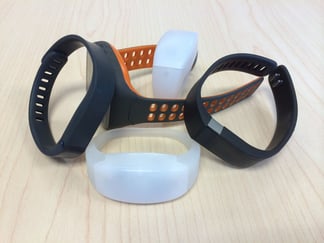As you must with any new technology, your health-care practice needs to consider information security issues when moving to wearable health-care monitors.

Using cloud computing, these devices connect patients with your practice, which comes with network and information security risks that must be addressed. Risk management can help you take advantage of the benefits wearable health monitors offer, while protecting your practice and patient data.
Ubiquitous Health-Care Wearable Devices
Wearable devices that monitor health care are popping up everywhere. Great for managing treatment, these devices can monitor things like blood pressure, heart rate, exercise and much more. Benefits of using these devices include reducing costs in monitoring health and improving diagnoses. Some of this wearable health-care technology is even built right into the new Apple iOS software and smartwatch.
Cloud Integration Convenience Versus Security
While it is important for health-care professionals to have access to the information collected by wearable devices, it's equally important to keep this data secure. Patient health-care data is some of the most private information you hold.
The issues of highest concern include:
- Violations of privacy – When patient data is mishandled, it can cause information-security violations. This can result in civil and criminal penalties resulting from failure to comply with HIPAA and other regulations.
- Disruptions in syncing to the cloud – Since these wearable devices are transmitting important medical data to health-care providers, any problems syncing to the cloud can become very dangerous. If your phone does not sync your photos to the cloud, you can just wait until tomorrow. However, if your health monitor doesn't send its data to your doctor, it can be a matter of life and death.
- Valuable medical information can be sold for insurance fraud – Another growing problem is the misuse of medical data for insurance fraud. For this purpose, criminals break into medical offices and hack databases to steal medical information. With the growing use of wearable health-care monitors, there is the possibility of devices intercepting transmissions to acquire medical data.
Maintaining Security while Retaining Advantages
There are a few things we can do to ensure security while taking full advantage of the benefits offered by health-care wearables. First, be sure to purchase wearable health monitors that are designed for security. Second, share best practices of software risk management among other health-care professionals. Third, collaborate with designers and manufacturers of wearables and health-care software to improve security of patient data. It's important to be able to openly discuss any security issues as well as the transmission of health data. Finally, ensure that you have appropriate physical and data security controls in place that align with current best practices. This will help your office stay ahead of data breaches and keep patient information as safe as possible.
Wearable health-care devices offer a number of benefits that can greatly improve patient care. It's essential to consider information security when bringing wearable health devices into your practice, and Vala Secure can help.

